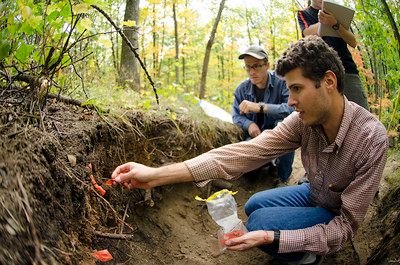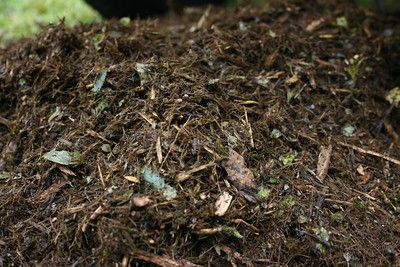5 Abiotic Factors in the Forest Ecosystem and Their Characteristics
Abiotic factors in the forest ecosystem are; sunlight, soil, water, atmospheric gases, and physicochemical parameters (like pH, temperature and electrical conductivity).
This article discusses abiotic factors in the forest ecosystem and their characteristics, as follows;
1). Sunlight (as one of the Abiotic Factors in the Forest Ecosystem)
Sunlight is one of the most important abiotic factors in forests.
The term 'sunlight' simply describes visible light that is emitted from the Sun and projected toward the Earth's surface. It is one of various types of electromagnetic energy that come from the Sun, alongside thermal energy in infrared solar rays.
Sunlight is an abiotic factor because it is part of solar energy; which comes from fusion reactions involving inorganic nuclear elements (that is; hydrogen isotopes) [2].
There are multiple roles played by sunlight and solar thermal energy in forests, as is the case for all types of terrestrial and aquatic ecosystems. Both biotic and abiotic components of forests depend on sunlight (directly or indirectly) for their continuity.
The function and structure of the forest ecosystem are shaped by sunlight.
Sunlight is essential for photosynthesis, by which forest plants manufacture their food. These plants are the primary producers of forest food chains, meaning that without sunlight, the production and recycling of biomass and bioenergy in forests, will be inhibited.
By influencing plant photosynthesis and growth, sunlight also determines the structure of forest canopies [3], in terms of the density and distribution of vegetation both vertically and horizontally.
Since plant species differ in their need for, and tolerance of, sunlight; this abiotic factor can be said to directly influence the species richness of forest plant-communities.
Heat which is supplied along with sunlight, affects micro-climatic conditions of forests. The same heat affects the hydrological cycle, and metabolic rates of forest organisms [5].
Lastly, sunlight facilitates forest plant-growth, making the forest an efficient carbon sink through the carbon-sequestration activities of plants.
2). Soil
Forest soil comprises of both abiotic and biotic elements.
However, the bulk of soil is constituted by rock fragments, sediments, water, gases, and the inorganic remains of degraded organic materials. Because these materials are all inorganic, it is not wrong for soil to be holistically classified as an abiotic factor.
Like sunlight, forest soil is an immensely-important natural resource.
It provides structural support (by anchorage) to forest plants, while containing many of the essential nutrients they need to survive.
At the same time, the soil serves as a natural storage-medium for organic carbon, which can be retained in soil for extended periods of time. By retaining carbon, forest soils keep this element away from the atmosphere, where it would otherwise occur as carbon dioxide; a greenhouse gas and potential-contributor to climate change.
Forest soil is a product of diverse processes that include organic biodegradation, activities like burrowing and detrivorous feeding; as well as physical processes like weathering and erosion.
It is also a micro-ecosystem of its own, with its food chain(s) and energy pyramids.
In forest soils, several organic species can be found, including various worms, insects, and microscopic groups like bacteria and fungi.
These attributes make soil indispensable to forests. Their (the soils') relevance extends beyond conditions of the immediate environment, to include regional conditions and biogeochemical cycles such as carbon, nitrogen, water and oxygen cycles respectively.

3). Water (as one of the Abiotic Factors in the Forest Ecosystem)
Water is another important abiotic factor in the forest ecosystem, which affects both biotic and abiotic aspects of their surrounding.
Water tends to affect other abiotic factors in an ecosystem immensely; by controlling physicochemical parameters like humidity, temperature and pH; as well as processes like soil erosion.
Because it is vital for organic survival, water in ecosystems serves as a link between the biotic and abiotic components.
The forms in which water may occur, in forests, include; water bodies like rivers, lakes and ponds; and precipitation such as rainfall.
Water bodies in forests constitute micro-ecosystems of their own, by serving as habitat to amphibians, fish, algae and some aquatic reptiles among others. These organisms are considered part of the forest species, and contribute to the high biodiversity of forests.
Precipitation is an important form in which water occurs in forests. It is particularly abundant in tropical rainforests [1], and is partly responsible for the distinct climatic and ecologic conditions in such zones. Water bodies are also recharged by precipitation.
Forest water resources play a role in the distribution and cycling of nutrients, which they often dissolve and carry as solutes.
Lastly, water acts as an energy-storage system in forests, by absorbing and retaining thermal energy for significant lengths of time.
Water is sometimes omitted when listing the abiotic factors of oceans and other aquatic ecosystems, simply because it is the ambient medium in these ecosystems.
4). Atmospheric Gases
Atmospheric gases are considered abiotic factors because they are not organic compounds.
The importance of abiotic factors in forest ecosystems ranges from organic respiration and survival to air currents, wind-dynamics, and climatic conditions.
Examples of atmospheric gases in forest ecosystems are; oxygen (O2), nitrogen (N2), and carbon dioxide (CO2). Others are trace gases, including oxides of sulfur and nitrogen, and ozone (O3).
Oxygen (O2) is needed for respiration by organisms both on land and in water. It supports aerobic cellular processes, which supply energy for organisms to carry out their activities.
Nitrogen (N2) is present in organic compounds like protein and DNA. It can be stored in the soil by some microbes through enzymatic processes collectively referred to as nitrogen fixation [4]. When present in soil, nitrogen serves as an essential nutrient for plant growth.
Carbon dioxide (CO2) is an important greenhouse gas that is captured from the atmosphere by forest plants, which use it for photosynthesis.

5). Physicochemical Parameters (as one of the Abiotic Factors in the Forest Ecosystem)
As the term implies, physicochemical parameters are quantities having both physical and chemical attributes.
Examples of physicochemical parameters in forests are pH, temperature, acidity, humidity, Cation Exchange Capacity (CEC) and salinity. The particular parameters analyzed at any given time depends on the part of the forest ecosystem that is being studied.
Physicochemical parameters of forest atmosphere, differ from those of forest soils and water bodies, respectively.
The physicochemical parameters of forest atmosphere include temperature, humidity and light intensity.
Physicochemical parameters of forest soils include; moisture content, texture, temperature, pH, salinity, oxygen concentration, and Cation Exchange Capacity (CEC).
Water bodies in forests can be studied using parameters like pH, dissolved oxygen (DO), salinity, turbidity, light penetration, electrical conductivity, and temperature.
Conclusion
Abiotic factors in the forest ecosystem are;
1. Sunlight
2. Soil
3. Water
4. Atmospheric Gases
5. Physicochemical Parameters
References
1). Hartshorn, G. (2013). "Tropical Forest Ecosystems." Encyclopedia of Biodiversity (pp.269-276). Available at: https://doi.org/10.1016/B978-0-12-384719-5.00146-5. (Accessed 22 May 2023).
2). Martinez, J. (2022). "Remarks on Nuclear Fusion Energy: Advantages, and Disadvantages." Available at: https://ssrn.com/abstract=4109155, or http://dx.doi.org/10.2139/ssrn.4109155. (Accessed 22 May 2023).
3). Matloobi, M. (2012). "Light Harvesting and Photosynthesis by the Canopy." Advances in Photosynthesis - Fundamental Aspects. Available at: https://doi.org/10.5772/27592. (Accessed 22 May 2023).
4). Rivas, Y.; Aponte, H.; Matus, F. J.; Martinez, O.; Encina, C.; Retamal-Salgado, J. (2023). "Microbial Community and Enzyme Activity of Forest Plantation, Natural Forests, and Agricultural Land in Chilean Coastal Cordillera Soils." Forests 14(5):938. Available at: https://doi.org/10.3390/f14050938. (Accessed 22 May 2023).
5). Schulte, P. M. (2015). "The effects of temperature on aerobic metabolism: towards a mechanistic understanding of the responses of ectotherms to a changing environment." J Exp Biol. 2015 Jun;218(Pt 12):1856-66. Available at: https://doi.org/10.1242/jeb.118851. (Accessed 22 May 2023).




